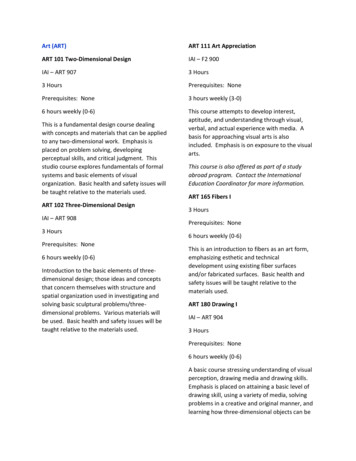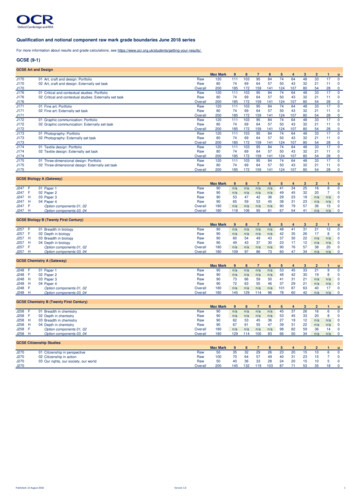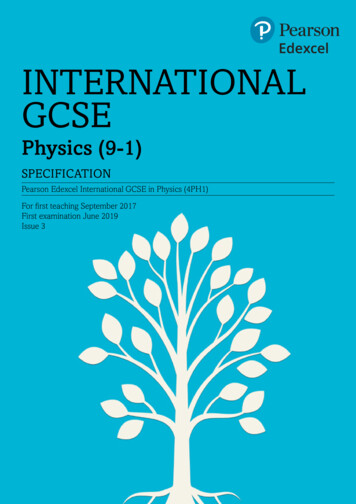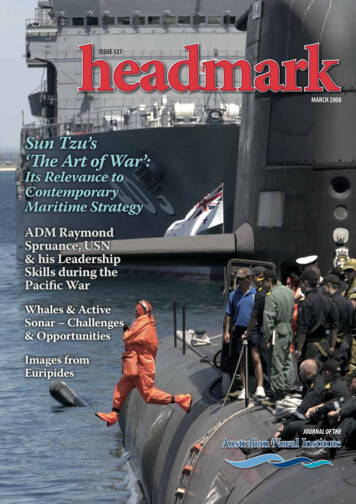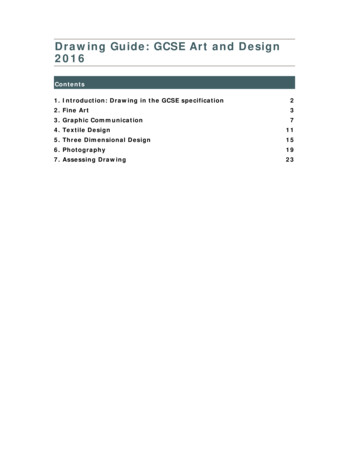
Transcription
Drawing Guide: GCSE Art and Design2016Contents1. Introduction: Drawing in the GCSE specification22. Fine Art33. Graphic Communication74. Textile Design115. Three Dimensional Design156. Photography197. Assessing Drawing23
Drawing in the GCSE Art & Design specification1. Introduction: Drawing in the GCSE specificationThe GCSE Art and Design specification requires that all students submitevidence of drawing. This applies equally across each endorsed title.Drawing is a new explicit requirement in GCSE Art and Design, and studentswill be expected to use drawing to support the development process withintheir chosen area(s) of study.There is a need for all students to develop understanding and skills in formsof drawing that are appropriate to their chosen specification title and thecontext in which the drawing is undertaken. Students should use drawingskills for different needs and purposes, to support the development processappropriate to their specification title and area(s) of study. However, it isimportant to understand that students are not always required todemonstrate technical mastery unless this is appropriate to their chosenarea(s) of study. Students should seek to use mark making as a way ofdeveloping and expressing their ideas.Drawing may take different forms. For example, it could be shown throughthe use of mark making as a way of recording ideas, observations orinsights. Other ways of drawing may include two- and three-dimensionaldesigns, storyboarding, stitch or collage. Examples of specific forms ofdrawing can be found in the individual specification titles. Drawing may takethe form of mark making, sketching or linear representations usingappropriate traditional and digital media.Students across all the endorsed titles should be encouraged to record theobserved world using mark making in a medium appropriate to theirintentions. Drawing should form part of the artistic journey as studentsdevelop ideas, work imaginatively, refine work, respond to the work ofothers and create outcomes.Drawing can be critical and/or accurate as well as explorative andexperimental. It takes many forms from two-dimensional mark making, tolines made using materials to define three-dimensional space.Drawing should not only be seen as a technical skill but as part of the ongoing work that a student produces in addressing the assessment objectivesof both component 1 and component 2
2. Fine ArtDrawing can be applied in all its forms across traditions and technologies and itcan be critical and accurate as well as explorative and experimental Fine Artpractitioners use drawing as a process to help them explore ideas, consolidateideas and communicate their thinking to others.Students should be encouraged to select and use a variety of traditional and/orexperimental drawing materials, such as: graphite and coloured pencils,charcoal, pastel, biro, pen and ink, paint, printed, stitched, collaged, and mixedmedia and digital recording. The use of different drawing media in bothcontrolled and experimental techniques will help students understand thequalities of the materials and address the requirement that they use drawing fordifferent purposes.In Fine Art students recording from observation could work in a traditional anddescriptive way or they could use expressive mark making to document theirresponse to things seen. Drawing and mark making can be used to exploreemotions, as well as capturing an expression, atmosphere or tension.During a gallery visit students could be encouraged to make observationalstudies, diagrams, sketches of images, objects and artefacts they find inspiring.The process of drawing could be used to explore the composition of images andto support their analysis of work by other artists.Drawing As a form of visual communication will support students in workingsensitively and thoughtfully to document their artistic journey and fully supporttheir intentions.In developing ideas for an outcome, for example a painting or sculpture studentscan use drawing to communicate their initial thoughts, to refine the idea and toplan for the resolved outcome.It is important that the practise of drawing is evident throughout a student’sportfolio.The following drawings are all examples of student’s work, made in differentways, they have been selected to help define what drawing is in the context ofthe GCSE Fine Art endorsed title.
Drawing used to record the observed world. Creatingsustained detailed drawings or quick sketches thatdocument a moment.Using line to show shape, structure and pattern.Drawing with tone to model form and explore theeffect of light.Drawing with different media to understand surfacequalities
Drawing as abstract mark makingUsing different media to createdrawings that explore the formalelementsDrawings made to analyse and explore the work of other artists
Examples of drawingused to develop ideas andto experiment with bothprocess and outcomeDrawing used toproduce resolvedoutcomes as part ofcomponent 1 and forthe externally setassignment incomponent 2
3. Graphic CommunicationDrawing in Graphic Communication is inherent in the process from initial idea tofinal realisation of the product. Sketches to final working drawings, includingdigital drawings, all form part of the essential process of exploration andplanning. Students should create drawings from both primary and secondarysources using a range of media, techniques and processes. Students might alsobe aware of new and emerging technologies, which can be used in the processesof drawing and mark making.Within the context of Graphic Communication drawing may take the form ofillustrations, layout, typography created using appropriate media and materials.At the start of the design process students could use drawing to gather visualresearch and develop ideas through an experimental approach to combiningdifferent media. Drawings could be scanned and reworked, altered, enhancedand manipulated in appropriate software or apps.As part of the design process students could develop ideas for an illustrationinformed by their own initial first hand drawings and experiments with materials.Traditional drawing processes have equal merit to those digitally produced andstudents are encouraged to work in the process that best suits their intentionsand resources available.Students may find formal drawing techniques including technical and measureddrawing are appropriate to their design process or the range of printmakingtechniques and collage could provide opportunities for students to be inventivewith their drawing and mark-making.Drawing will form an important part of the refining of ideas and planning.Drawing may also feature strongly in a student’s final outcome.The following drawings are all examples of student’s work, made in differentways, they have been selected to help define what drawing is in the context ofthe GCSE Graphic Communication endorsed title.
Drawing to gather visual researchDrawing inresponse to thework of otherartists anddesigners
Developing ideas, drawing with colour and patternDrawing toexperiment withfont and to designtypeface.
Using software programmes to create digital drawings and as part of the design process.Using drawing to produce GraphicOutcomes
4. Textile DesignDrawing is an essential skill in the development process of Textile Design, frominitial visual research, recording from primary and secondary sources, through tothe translation of ideas into finished designs. Drawing in Textile Design canembrace a range of tools across all areas of study, and outcomes can be digitaland/or non-digital.Students could experiment with paper pattern making or investigate how toillustrate ideas through fashion drawing. Drawing can be evident when using arange of textile materials, for example in textural collage work, applique orembellishment when creating accessories or artefacts.Working drawings are a key element of the design and making process, thesecan be in the form of quick thumbnail sketches or more detailed visualillustrations of their ideas.Drawing may involve the use of needle and thread, stitching by hand or machine.Students could create embroidered illustrations and more abstract work, usingthreads of different weights to make different types of marks.It is important that the practise of drawing is evident throughout a student’sportfolio.The following drawings are all examples of student’s work, made in differentways, they have been selected to help define what drawing is in the context ofthe GCSE Textile Design endorsed title.
Using drawing to make visual researchin TextilesDrawing with textilematerials
Drawing in response to the work of other artists anddesigners.Using digital technology to develop drawing into repeat patterns
Drawingused as partof theplanning anddesignprocess inTextilesDrawing as part of the textile process in producing an outcome
5. Three Dimensional DesignStudents of Three dimensional Design need to demonstrate how a threedimensional world can be translated into a two-dimensional one throughtechnical and free hand drawings. It is important to develop drawing skills toexpress ideas, using different tools, materials and techniques. The formalelements should also be applied, especially those such as texture, colour andlight.Drawing may take the form of Marquette, scale model(s) and computer-aideddesign using media and materials appropriate to intentions. The Marquette canbe seen as a rough draft of an idea that may be reviewed and refined or as afinal draft made to consider scale before production.Students could demonstrate their understanding of the structure of objectsthrough drawing methods when working with, for example, wire, withies, or clay.It is important to use the chosen materials in the early drawing and planningstages of the design process to develop an understanding of the medium and itspotential for the realisation of an idea.In three dimensional design students can use working drawings that illustrate thedifferent dimensions of a design idea or illustrate how materials may be joinedtogether. This may be a in the form of a technical illustration, a series ofthumbnail sketches or computer aided design.Students could record the progression of their work and ideas with drawingsmade in traditional and/or digital media.It is important that the practise of drawing is evident throughout a student’sportfolio.The following drawings are all examples of student’s work, made in differentways, they have been selected to help define what drawing is in the context ofthe GCSE Three-Dimensional Design endorsed title.
Drawing as research from observationDrawing with 3DD materialsDrawing in response to the work of artists and designers
Drawing toexplore anddevelop ideasUsing new technologies and CAD to develop drawings as part of the design process
Making Marquette’s to explore three dimensional spaceDrawing as Three- Dimensional Design outcome
6. PhotographyThe word photography could be taken to mean ‘a graphic representation withlight’. In this way a photograph could be described as drawing with light.Drawing methods such as pen or pencil on paper may enhance students’development and understanding of photographic ideas, for example to planshots, analyse and deconstruct their own imagery, or record ways in whichpractitioners have used formal elements and visual language. Students shoulduse a variety of tools and materials, as appropriate, for recording theirsurroundings and source materials.Drawing may take the form of diagrams or story boards which plan andpositioning of lights and use of photographic equipment can be shown in theform of a plan or map.When working with chemicals in the darkroom students could use anexperimental abstract mark making to produce a chemigram. The Scratching intonegatives and film is another approach the uses abstract mark making to createand alter imagery.In post-production photographic images could be drawn on to using a wide rangeof different materials and techniques: Stitching with threads, paints or markerpens, collage or print.Within photography drawings can visualise the result of digital manipulation, orthe use of a variety of software applications, Photoshop or apps. Digital softwareapplications all have an extensive range of tools that enable students to drawinto photographs.It is important that the practise of drawing is evident throughout a student’sportfolio.The following drawings are all examples of student’s work, made in differentways, they have been selected to help define what drawing is in the context ofthe GCSE Photography endorsed title.
Drawing with light in response to things seen using both traditional and digital processes
Demonstrating evidence of using Photoshop and apps to develop and enhance images.
Drawings made by working over thetop of a photograph, to enhance theimage or to experiment with surfacequalities
7. Assessing DrawingWhen making assessment judgements about drawing you should consider whatthe drawing evidence contributes to the student’s creative journey and creativeintentions. What value does the drawing evidence have within the body of workas a whole? To what extent the drawing evidence addresses’ the fourAssessment Objectives and contributes to the coverage of the areas of studyrequired by the endorsed title specification.It is important to remember that Drawing can form part of a student’s evidencefor any and all of the four Assessment Objectives, as relevant to the student’screative intentions. Therefore, drawing should be assessed through all four of theAssessment Objectives.A student’s investigations into drawing materials techniques and methods can bepresented in a variety of ways including sketchbooks, notebooks, worksheets,design sheets, different scale rough studies, samples, swatches, test pieces,maquettes and/or digital material in any medium and scale.A comprehensive bank of exemplar student work and examiner commentaries tohelp you understand the standard has been provided and can be accessed viathe Pearson g-support/understanding-the-standard.html
5. Three Dimensional Design Students of Three dimensional Design need to demonstrate how a three-dimensional world can be translated into a two-dimensional one through technical and free hand drawings. It is important to develop drawing skills to express ideas, using different too

